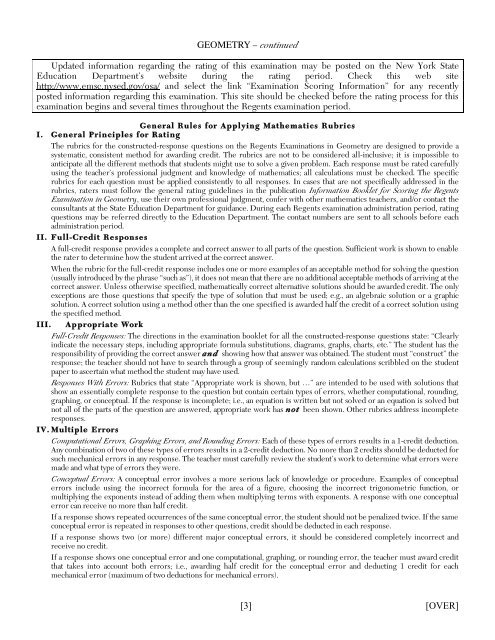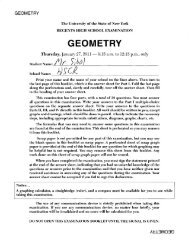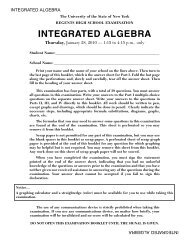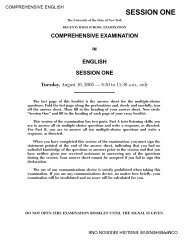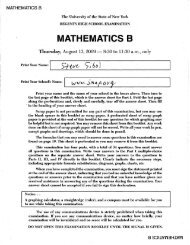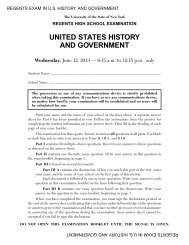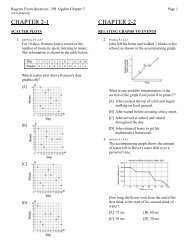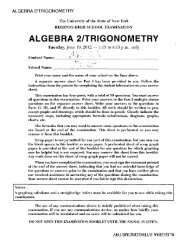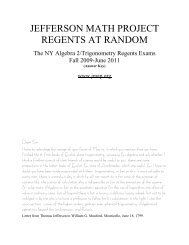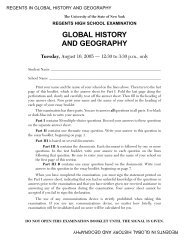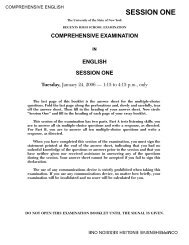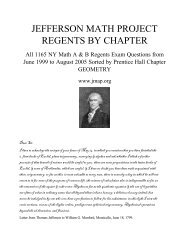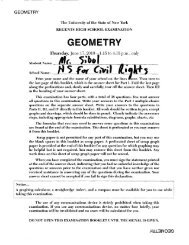GEOMETRY - JMap
GEOMETRY - JMap
GEOMETRY - JMap
You also want an ePaper? Increase the reach of your titles
YUMPU automatically turns print PDFs into web optimized ePapers that Google loves.
<strong>GEOMETRY</strong> – continued<br />
Updated information regarding the rating of this examination may be posted on the New York State<br />
Education Department’s website during the rating period. Check this web site<br />
http://www.emsc.nysed.gov/osa/ and select the link “Examination Scoring Information” for any recently<br />
posted information regarding this examination. This site should be checked before the rating process for this<br />
examination begins and several times throughout the Regents examination period.<br />
General Rules for Applying Mathematics Rubrics<br />
I. General Principles for Rating<br />
The rubrics for the constructed-response questions on the Regents Examinations in Geometry are designed to provide a<br />
systematic, consistent method for awarding credit. The rubrics are not to be considered all-inclusive; it is impossible to<br />
anticipate all the different methods that students might use to solve a given problem. Each response must be rated carefully<br />
using the teacher’s professional judgment and knowledge of mathematics; all calculations must be checked. The specific<br />
rubrics for each question must be applied consistently to all responses. In cases that are not specifically addressed in the<br />
rubrics, raters must follow the general rating guidelines in the publication Information Booklet for Scoring the Regents<br />
Examination in Geometry, use their own professional judgment, confer with other mathematics teachers, and/or contact the<br />
consultants at the State Education Department for guidance. During each Regents examination administration period, rating<br />
questions may be referred directly to the Education Department. The contact numbers are sent to all schools before each<br />
administration period.<br />
II. Full-Credit Responses<br />
A full-credit response provides a complete and correct answer to all parts of the question. Sufficient work is shown to enable<br />
the rater to determine how the student arrived at the correct answer.<br />
When the rubric for the full-credit response includes one or more examples of an acceptable method for solving the question<br />
(usually introduced by the phrase “such as”), it does not mean that there are no additional acceptable methods of arriving at the<br />
correct answer. Unless otherwise specified, mathematically correct alternative solutions should be awarded credit. The only<br />
exceptions are those questions that specify the type of solution that must be used; e.g., an algebraic solution or a graphic<br />
solution. A correct solution using a method other than the one specified is awarded half the credit of a correct solution using<br />
the specified method.<br />
III. Ap propriate Work<br />
Full-Credit Responses: The directions in the examination booklet for all the constructed-response questions state: “Clearly<br />
indicate the necessary steps, including appropriate formula substitutions, diagrams, graphs, charts, etc.” The student has the<br />
responsibility of providing the correct answer an d showing how that answer was obtained. The student must “construct” the<br />
response; the teacher should not have to search through a group of seemingly random calculations scribbled on the student<br />
paper to ascertain what method the student may have used.<br />
Responses With Errors: Rubrics that state “Appropriate work is shown, but …” are intended to be used with solutions that<br />
show an essentially complete response to the question but contain certain types of errors, whether computational, rounding,<br />
graphing, or conceptual. If the response is incomplete; i.e., an equation is written but not solved or an equation is solved but<br />
not all of the parts of the question are answered, appropriate work has not been shown. Other rubrics address incomplete<br />
responses.<br />
IV. Multiple Errors<br />
Computational Errors, Graphing Errors, and Rounding Errors: Each of these types of errors results in a 1-credit deduction.<br />
Any combination of two of these types of errors results in a 2-credit deduction. No more than 2 credits should be deducted for<br />
such mechanical errors in any response. The teacher must carefully review the student’s work to determine what errors were<br />
made and what type of errors they were.<br />
Conceptual Errors: A conceptual error involves a more serious lack of knowledge or procedure. Examples of conceptual<br />
errors include using the incorrect formula for the area of a figure, choosing the incorrect trigonometric function, or<br />
multiplying the exponents instead of adding them when multiplying terms with exponents. A response with one conceptual<br />
error can receive no more than half credit.<br />
If a response shows repeated occurrences of the same conceptual error, the student should not be penalized twice. If the same<br />
conceptual error is repeated in responses to other questions, credit should be deducted in each response.<br />
If a response shows two (or more) different major conceptual errors, it should be considered completely incorrect and<br />
receive no credit.<br />
If a response shows one conceptual error and one computational, graphing, or rounding error, the teacher must award credit<br />
that takes into account both errors; i.e., awarding half credit for the conceptual error and deducting 1 credit for each<br />
mechanical error (maximum of two deductions for mechanical errors).<br />
[3] [OVER]


